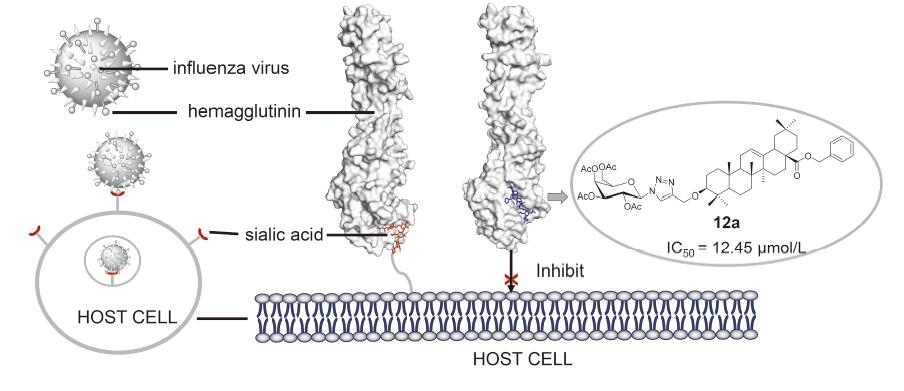| [1] |
CDC. Influenza Type A Viruses[EB/OL]. [2017-04-19]. https: //www. cdc. gov/flu/avianflu/influenza-a-virus-subtypes. htm
|
| [2] |
Kilbourne; Edwin, D. Emerg Infect Dis. 2006, 12(1),9.
|
| [3] |
van Dongen, M.; Kadam, R. U.; Juraszek, J.; Lawson, E.; Brandenburg, B.; Schmitz, F.; Schepens, W.; Stoops, B.; van Diepen, H. A.; Jongeneelen, M.; Tang, C.; Vermond, J.; van Eijgen-Obregoso Real, A.; Blokland, S.; Garg, D.; Yu, W.; Goutier, W.; Lanckacker, E.; Klap, J. M.; Peeters, D.; Wilson, I. A. Science. 2019, 363(6431),6221.
|
| [4] |
Fang, Y.; Xiao, M.; Hu, A.; Ye, J.; Lian, W.; Liu, A. Chin J. Chem. 2016, 34,403.
|
| [5] |
Sheu, T. G.; Fry, A. M.; Garten, R. J.; Deyde, V. M.; Shwe, T.; Bullion, L.; Peebles, P. J.; Li, Y.; Klimov, A. I.; Gubareva, L. V. J Infect Dis. 2011, 203(1),13.
|
| [6] |
Hay, A. J.; Hayden, F. G. Lancet. 2013, 381(9885),2230.
|
| [7] |
Heo, Y. A. Drugs. 2018, 78(6),693.
|
| [8] |
Hayden, F. G.; & Shindo, N. Curr Opin Infect Dis. 2019, 32(2),176.
|
| [9] |
Vanderlinden, E.; Naesens, L. Med. Res. Rev. 2014, 34,301.
|
| [10] |
Zhao, X.; Li, R.; Zhou, Y.; Xiao, M.; Ma, C.; Yang, Z.; Zeng, S.; Du, Q.; Yang, C.; Jiang, H.; Hu, Y.; Wang, K.; Mok, C K P.; Sun, P.; Dong, J.; Cui, W.; Wang, J.; Tu, Y.; Yang, Z.; Hu, W. J Med Chem. 2018, 61(12),5187.
|
| [11] |
Yu, M.; Si, L.; Wang, Y.; Wu, Y.; Yu, F.; Jiao, P.; Shi, Y.; Wang, H.; Xiao, S.; Fu, G.; Tian, K.; Wang, Y.; Guo, Z.; Ye, X.; Zhang, L.; Zhou, D. J. Med. Chem. 2014, 57,10058.
|
| [12] |
Li, S.; Jia, X.; Shen, X.; Wei, Z.; Jiang, Z.; Liao, Y.; Guo, Y.; Zheng, X.; Zhong, G.; Song, G. Bioorg Med Chem. 2017, 25(16),4384.
|
| [13] |
Song, G.; Shen, X.; Li, S.; Li, Y.; Si, H.; Fan, J.; Li, J.; Gao, E.; Liu, S. Eur J Med Chem. 2016, 119,109.
|
| [14] |
Song, G.; Shen, X.; Li, S.; Si, H.; Li, Y.; Luan, H.; Fan, J.; Liang, Q.; Liu, S. RSC Adv. 2015, 5,39145.
|
| [15] |
Su, Y.; Meng, L.; Sun, J.; Li, W.; Shao, L.; Chen, K.; Zhou, D.; Yang, F.; Yu, F. Eur J Med Chem. 2019, 182,111622.
|
| [16] |
Conte, G.; Cristiano, R.; Ely, F.; Gallardo, H. Synth. Commun. 2006, 36,951.
|
| [17] |
Chittaboina, S.; Xie, F., Wang, Q. (2005). Tetrahedron Letters 2005, 46(29),2331.
|
| [18] |
Maier, M. A.; Yannopoulos, C. G.; Mohamed, N.; Roland, A.; Fritz, H.; Mohan, V.; Just, G.; Manoharan, M. Bioconjug Chem. 2003, 14(1),18.
|
| [19] |
Zhao, S.; Zhang, S.; Xu, J.; Hu, L. Tetrahedron. 2020, 76(42),131517.
|
| [20] |
Tang, Y.; Zhang, S.; Chang, Y.; Fan, D.; Agostini, A.; Zhang, L.; Jiang, T. J Med Chem. 2018, 61(7),2937.
|
| [21] |
Andreeva, O.; Garifullin, B.; Sharipova, R.; Strobykina, I.; Sapunova, A.; Voloshina, A.; Belenok, M.; Dobrynin, A.; Khabibulina, L.; Kataev, V. J Nat Prod. 2020, 83(8),2367.
|
| [22] |
Tsoulougian, V.; Psykarakis, E.; Gimisis, T. Org Biomol Chem. 2019, 17(4),973.
|
| [23] |
Novoa, A.; Machida, T.; Barluenga, S.; Imberty, A.; Winssinger, N. Chembiochem. 2015, 15(14),2058.
|
| [24] |
Yu, F.; Zheng, Y.; Peng, Y.; Zhou, D.; Xiao, S. Design and synthesis of oleanolic acid rings a and c lactone derivatives. Chin. J. Org. Chem, 2016, 36,512(in Chinese).
|
|
(俞飞, 郑永祥, 彭逸云, 周德敏, 肖苏龙, 有机化学, 2016, 36,512.)
|
| [25] |
Li, W.; Yang, F.; Meng, L.; Sun, J.; Su, Y.; Shao, L.; Zhou, D.; Yu, F. Chem. Pharm Bull. 2019, 67(11),1201.
|
 )
)
